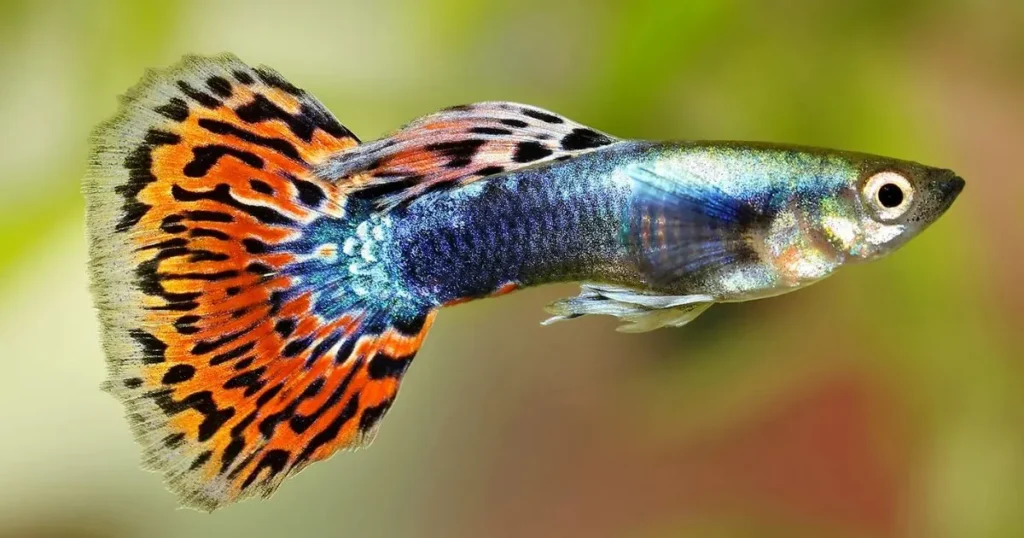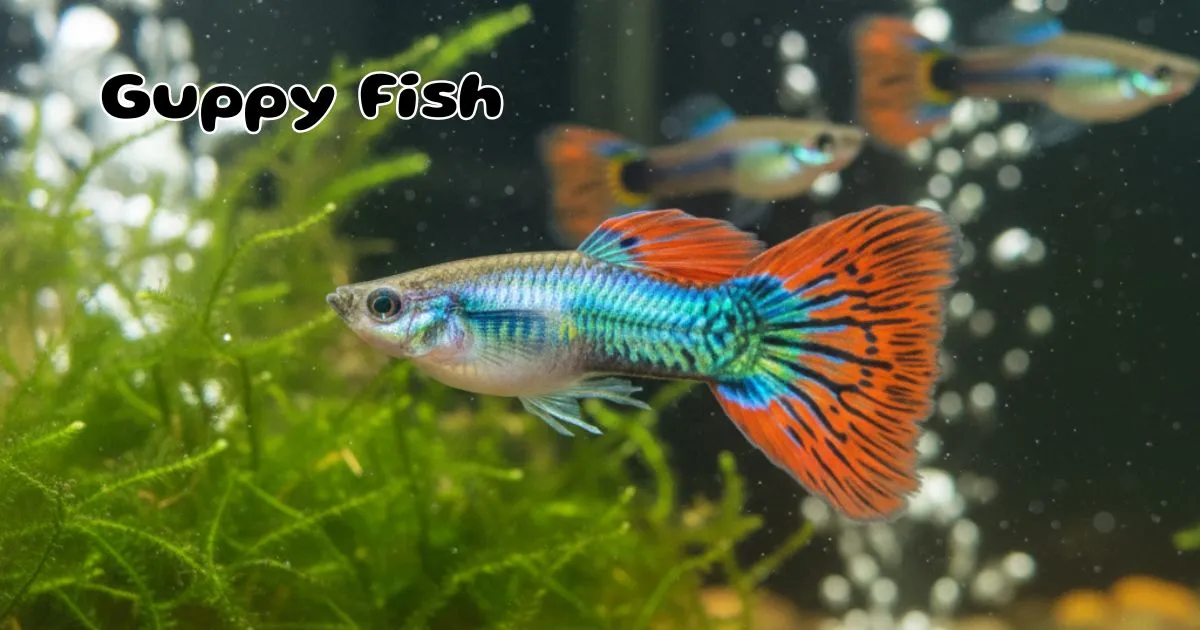Imagine having a splash of color in your room or a tiny, lively friend swimming happily in a small glass tank. That’s exactly what guppies do: they bring joy, sparkle, and life to any space. If you’ve ever thought about starting your own fish tank but didn’t know where to begin, guppies are your perfect match!
Guppy fish care is surprisingly simple, even for beginners. They’re not just pretty, they’re hardy, colorful, and don’t require fancy equipment or complicated setups. Plus, they’re super friendly and love to show off their vibrant colors, making them a favorite among new and seasoned fish lovers alike.
What Is a Guppy Fish? Basic Facts and Species Overview

Now, you might be wondering, “What exactly is a guppy fish?” Well, guppies, or Poecilia reticulata, are small freshwater fish that originated in South America. Famous for their bright colors and energetic swimming, they come in a rainbow of shades: reds, blues, greens, and more.
These little livebearers give birth to tiny baby fish, called fry, instead of laying eggs. This makes watching guppy breeding a fun and educational experience. Their colorful tails and lively antics have earned them the nickname “rainbow fish,” and they’re among the easiest fish to care for, even if you’re just starting out.
How Big Do Guppies Grow? Understanding Size and Growth Patterns
Adult guppies grow to about 1.5 to 2.5 inches long, small enough to fit comfortably in a 10 gallon tank or larger. Males are usually smaller and more colorful, while females tend to be bigger and less flashy. Knowing this helps pick healthy fish and plan tank space.
Since guppies don’t get too large, they don’t need massive tanks or complicated setups. Their small size also means they finish meals quickly, making feeding straightforward.
How to Set Up a Guppy Fish Tank: Size, Filtration, Lighting, and Decor

Setting up your guppy’s home is easier than you think. Start with a tank of at least 10 gallons for a small group, ideally 3 to 6 guppies, so they don’t feel crowded. Guppies love company and do best in groups.
Filtration keeps the water clean and healthy. A gentle sponge filter works great because it creates a steady flow without stressing your fish. Lighting should mimic natural daylight, so choose a light that’s bright but soft to help your guppies show off their sparkling colors.
Decorate with live or artificial plants, rocks, and hiding places. Plants like Java Moss or Hornwort give fry safe spots to hide and make the tank look vibrant. Think of these as cozy little apartments your fish will love to explore.
Read More: Types of Guppy Fish: A Detailed Guide for Beginners
What Water Parameters Do Guppies Need? (pH, Temperature, Hardness)
Guppies thrive in water that’s just right. They prefer a pH between 6.8 and 8.0, which is slightly alkaline but not harsh. Keep temperatures steady between 74°F and 82°F (23°C to 28°C). Too cold or too hot can make your guppies sluggish or sick.
Water hardness is important, too. Guppies like moderately hard water, around 8 to 12 dGH. Test your tank water regularly and use conditioners to adjust if needed. Keeping these factors stable helps your guppies live healthy, happy lives.
How Often Should You Change Guppy Tank Water? Maintaining a Healthy Environment

Changing water regularly keeps your guppy tank fresh without stressing your fish. Do partial water changes of about 10 to 25% every 2 to 4 weeks. Avoid changing all the water at once, or you risk wiping out beneficial bacteria that keep the tank’s ecosystem balanced.
Remove leftover food daily using a net to prevent buildup. This helps control ammonia levels, which can be harmful if they get too high. A clean tank is a happy tank, and your guppies will swim with extra zest when their home is sparkling.
What Do Guppies Eat? A Detailed Feeding Guide
Feeding guppies is simple but important for their health. They are omnivores who love a balanced diet combining plant and animal foods. High quality flakes or pellets designed for guppies or tropical fish are a great base.
Add frozen or live treats like brine shrimp, daphnia, or bloodworms once or twice a week to keep their diet exciting and nutritious. Feed small portions once or twice a day, just enough for your fish to eat in 2 to 3 minutes, to avoid leftovers that can dirty your tank.
Baby guppies (fry) need special care. They start feeding when they absorb their yolk sac and need tiny food like infusoria or crushed flakes several times daily to grow strong.
How Do You Breed Guppies? Tips for Successful Breeding and Fry Care

Breeding guppies can be super fun! Female guppies can give birth to about 20 to 40 fry every month. To protect the tiny fry from getting eaten by adult fish, it’s best to separate a pregnant female into a breeding tank just before she gives birth.
Provide lots of hiding places for fry, like fine leaved plants or breeding boxes. Feed newborn fry infusoria or specially formulated fry food several times a day. As they grow, gradually introduce crushed flakes and finely chopped foods. Watching your fry grow into colorful adults is one of the most rewarding parts of guppy fish care.
How Long Do Guppies Live? Factors Affecting Lifespan
With good care, guppies live about 2 to 3 years. Factors like clean water, proper diet, stable temperatures, and avoiding stress help extend their lives. Watch for signs of illness early and take action to keep your guppies thriving.
What Are Common Diseases in Guppies? Prevention and Treatment
Guppies are tough, but they can get sick. Common problems include Ich (white spots), fin rot, and fungal infections. Keep your tank clean, avoid overcrowding, and quarantine new fish to prevent disease.
If your guppies get sick, treatments like aquarium salt or medicated foods often help. Always follow instructions carefully. Healthy water and a stress free environment are your best defense against disease.
How to Select Healthy Guppies at the Pet Store: Expert Tips
When picking guppies, look for active, alert fish with bright colors and intact fins. Avoid fish that hide, have torn fins, or show white spots. Healthy guppies will swim smoothly and respond to food eagerly.
Can Guppies Live With Other Fish? Choosing Compatible Tank Mates
Guppies are peaceful but can be stressed by aggressive fish. Good tank mates include small tetras, mollies, platies, and peaceful bottom dwellers like corydoras catfish. Avoid large, aggressive, or fin nipping fish.
How to Monitor and Improve Guppy Fish Health Daily
Check your guppies daily for changes in behavior or appearance. Healthy guppies swim actively, eat well, and show vibrant colors. Clear eyes and clean fins are signs of good health. Promptly remove sick fish to protect the whole tank.
What Are the Signs of Stress in Guppies? How to Respond
Signs of stress include clamped fins, hiding more than usual, loss of appetite, and pale colors. Causes can be poor water quality, too much light, or overcrowding. Adjust tank conditions, do water changes, and give your fish some space to bounce back.
FAQ:
What Is the Best Environment for Guppies?
Guppies love clean, well maintained tanks with lots of partners, stable warm water, and plenty of plants for hiding. Avoid sudden changes in water or temperature to keep them happy.
How many guppies should I keep in my tank?
Guppies are social fish and prefer to be in groups. The general rule is at least 4 to 6 guppies per tank, but if you’re starting out, a minimum of 10 gallons is ideal for a small school of 3 to 6 guppies. For breeding purposes, keep one male with two or three females to prevent stress and overpopulation.
Do guppies breed easily?
Yes, guppies are prolific breeders and will breed readily if both males and females are kept together. They are livebearers, which means females give birth to live fry. To control breeding, separate males and females or provide plenty of hiding spots for fry if you want to enjoy their offspring.
What are the best tank conditions for guppies?
Guppies thrive in water with a pH between 6.8 and 8.0, with a temperature around 74 to 82°F (23 to 28°C). They prefer moderately hard water, around 8 to 12 dGH. Maintaining stable water parameters with regular water changes and good filtration is essential to keep them healthy and vibrant.
What should I feed my guppies?
Guppies love a varied diet. High quality flakes or pellets made specifically for tropical fish are perfect for daily feeding. Complement their diet with frozen or live foods like brine shrimp, bloodworms, or daphnia once or twice a week to enhance their colors and growth. Feed small amounts 1 to 2 times a day.
How long do guppies live, and what common health issues do they face?
Typically, guppies live for about 2 to 3 years. Common health problems include Ich (white spots), fin rot, and fungal infections, often caused by poor water quality or stress. Regular tank maintenance, proper diet, and avoiding overpopulation help prevent illness. Quarantine new fish before adding them to your main tank to avoid disease spread.
Advanced Guppy Care Tips: Maintaining Vibrant Colors and Activity
Feed a variety of foods, keep water pristine, and add vitamins or color enhancers sparingly. A healthy tank and stimulating environment help guppies show off their best.
Glossary of Guppy Care Terms
- Livebearer: A Fish that gives birth to live young rather than laying eggs.
- pH: Measurement of water acidity or alkalinity.
- Fry: Baby fish.
- Infusoria: Tiny microorganisms used as food for fish fry.
- dGH: Degree of general hardness of water.
Conclusion: Bringing Joy and Color with Proper Guppy Fish Care
Taking care of guppy fish is one of the most rewarding and accessible hobbies you can start. With their dazzling colors and lively personalities, guppies brighten any space and provide endless enjoyment. The key to a happy, healthy guppy tank lies in understanding their needs, from setting up the right tank and maintaining stable water conditions to feeding a balanced diet and nurturing their tiny fry.
